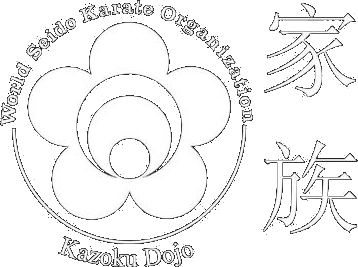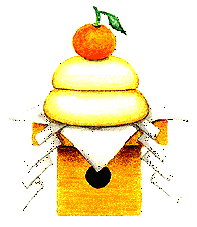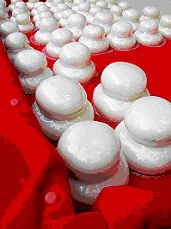

In Japan New Year wouldn't be the same without mochi, which is made by steaming and pounding a sticky type of rice (mochi gome). In the past, mochi was made at home, but most families today buy it ready-made. Over the holidays, a pair of round mochi (kagami mochi) the size of plates--one a little larger than the other--is stacked on a stand and placed in a household Shinto altar or tokonoma (alcove) as an offering to the deities that visit on New Year's. The ornamental mochi is removed on January 11 and broken into smaller pieces before being eaten.
By this time, the kagami mochi is usually quite brittle and cracks appear on the surface. The mochi is not cut with a knife since cutting has negative connotations (like "cutting off ties"). It's broken with one's hands or a hammer. The ritual of cracking of the kagami mochi is called "Kagami Biraki" or "Kagami Wari", meaning "open mirror" or "break open mirror.
The smaller pieces are roasted and put in shiruko (sweet soup of boiled beans) or zoni (vegetable and meat soup). By partaking of this offering to the gods, ancient people believed that they were inviting divine blessings.

|

|
| Home-Made Kagami Mochi | Mass-Produced Kagami Mochi |
Some sources connect the origin of the ceremony to Tokugawa Ietsuna, the 4th Shogun of the powerful Tokugawa clan. (ruled 1651-1680).
He gathered his Daimyo (feudal clans) at the castle of Chiyoda in preparation for a battle. According to one version, he displayed a mirror, performed a war dance in front of it and then prayed for victory. Others suggest that the ceremony was dedicated to break open a wooden Taru (sake barrel) with a wooden mallet. As Ietsuna won the battle, this would be the beginning of the "Kagami Biraki" ceremony.
Opening a sake barrel with a small mallet has been adapted for wedding banquets, congratulatory or completion ceremonies. Sake from the barrel is distributed to all attendants in the spirit of sharing the happy moment.
Others suggest that the origin of 'Kagami-biraki' traces back to the ancient Shinto rituals. At certain shrine festivals, "kami kagami" (divine mirrors) in sanctuaries were open for public worship.
Sake, which has been produced for more than 2000 years, has been revered and treated as sacred, considered spiritually refreshing. To this day, sake is still offered and dedicated when attending a religious shrine whilst one prays for peace and prosperity.
Kagami Biraki is not just a household affair. Many martial arts Dojo use the ceremony to signify their first practice of the New Year. Jigoro Kano, the founder of judo adopted it in 1884. His famous Dojo in Tokyo, the Kodokan, performs a mammoth Kagami Biraki ritual after a training session each year. The mochi is put in shiruko and shared by some 700 participants.
In our Dojo at Seido Kazoku, we only adhere to the spiritual meaning of the ceremony, we make the first training of the new year a vigorous workout of the group, together. We practice strong basic techniques with lots of kiai. We start the new year in high spirit, sharing good, strong energy. The ceremony signs the importance of the beginning. the new year, a new period of life.
© 2019 Seido Karate Kazoku Dojo
Web Hosting kindly provided by
Netsell ISP